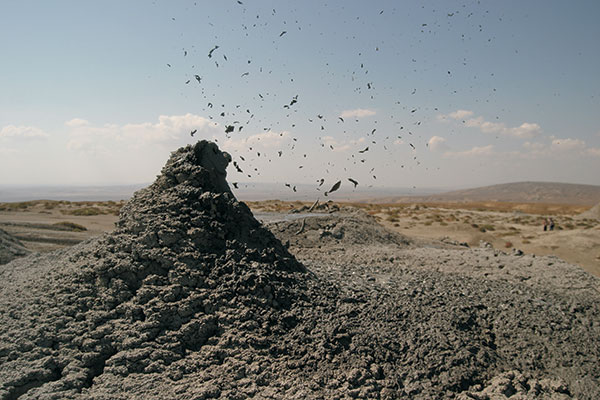Mud volcanoes are pervasive within the Republic of Azerbaijan. In local language, mud volcanoes are also known as "pilpila", "yanardagh", "bozdagh", "akhtarma", "gaynarja" etc. There are over 220 mud volcanoes in Azerbaijan (Absheron Peninsula, Gobustan, southeast Shirvan plain, Samur-Davachi plain terrane, both Absheron, and Baku Archipelago. The biggest are Galmas, Toraghay, Big Kanizadag, etc. Most of them have a cone shape. Their height varies in the range from 20 to 400 m, whereas base diameter may vary from 100 to 4500 m.
both Absheron, and Baku Archipelago. The biggest are Galmas, Toraghay, Big Kanizadag, etc. Most of them have a cone shape. Their height varies in the range from 20 to 400 m, whereas base diameter may vary from 100 to 4500 m.
Besides onshore mud volcanoes, there are buried volcanoes and offshore mud volcanoes. There are over 140 offshore mud volcanoes within the Caspian Sea. Eight Islands within the Baku archipelago were generated by mud volcanic eruptions (Khara-Zira, Zanbil, Garasu, Gil, Sangi-Mughan, Chigmil, etc). Buried mud volcanoes have been encountered by exploration wells. Ancient activities of mud volcanoes were identified among various age stratigraphic units. It is suggested that mud volcanoes activity within the Republic of Azerbaijan about 25,000 years ago. Usually, mud volcanoes eruption begins with a subsurface rumble followed by a strong burst. Gases coming out to the surface from deeply buried formations get ignited and blaze up. Flame tongues may at times reach up to 1000m high (Garasu mud volcano).
Observations indicate that 50 mud volcanoes have burst about 200 times since 1810 in Azerbaijan. Lock-Batan mud volcano erupted 19 times during that period. Mud volcanoes erupt mud, solid rock fragments, gas, and water. Mud volcanoes outbursts contain over 100 minerals and up to 30 chemical microelements (such as barite, mercury, manganese, copper, barium, strontium, lithium, etc). The origin of mud volcanoes is associated with buried hydrocarbon deposits. Prolific oil and gas -condensate fields have been discovered in areas characterized by mud volcanoes development (Lock-Batan, Neft Dashlary, Garadagh, Mishovdagh, etc). Mud volcanoes outbursts are used as the medical row material.
In 2007, 52 mud volcanoes were granted the status of state nature reserves by establishing the Baku and Absheron Peninsula Group's State Nature Reserve.



